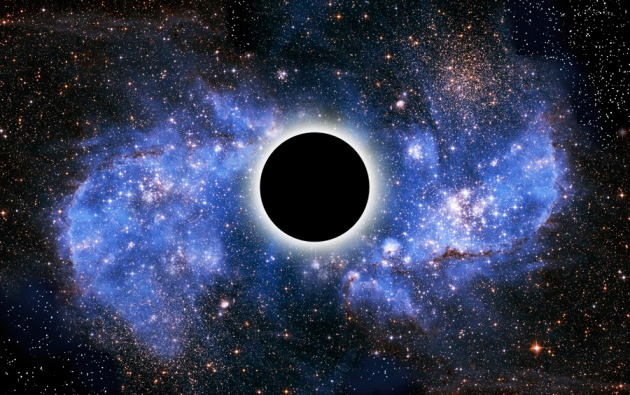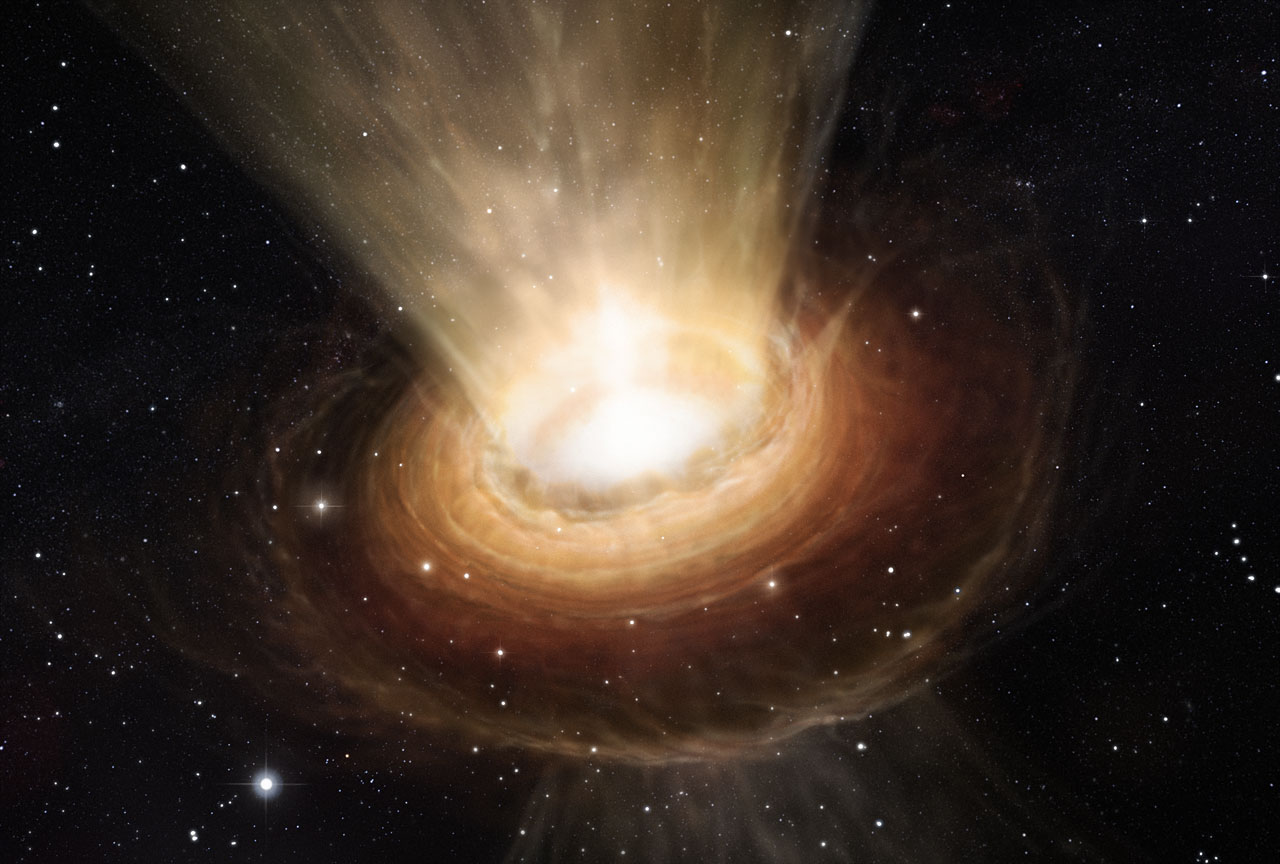Nature | Zeeya Merali | 2013 Sep 13
Big Bang was mirage from collapsing higher-dimensional star, theorists propose.
It could be time to bid the Big Bang bye-bye. Cosmologists have speculated that the Universe formed from the debris ejected when a four-dimensional star collapsed into a black hole — a scenario that would help to explain why the cosmos seems to be so uniform in all directions.The event horizon of a black hole — the point of no return for anything that falls in — is
a spherical surface. In a higher-dimensional universe, a black hole could have a three-
dimensional event horizon, which could spawn a whole new universe as it forms.
Artist's Impression by Victor De Schwanberg/Science Photo Library
The standard Big Bang model tells us that the Universe exploded out of an infinitely dense point, or singularity. But nobody knows what would have triggered this outburst: the known laws of physics cannot tell us what happened at that moment.
“For all physicists know, dragons could have come flying out of the singularity,” says Niayesh Afshordi, an astrophysicist at the Perimeter Institute for Theoretical Physics in Waterloo, Canada.
It is also difficult to explain how a violent Big Bang would have left behind a Universe that has an almost completely uniform temperature, because there does not seem to have been enough time since the birth of the cosmos for it to have reached temperature equilibrium.
To most cosmologists, the most plausible explanation for that uniformity is that, soon after the beginning of time, some unknown form of energy made the young Universe inflate at a rate that was faster than the speed of light. That way, a small patch with roughly uniform temperature would have stretched into the vast cosmos we see today. But Afshordi notes that “the Big Bang was so chaotic, it’s not clear there would have been even a small homogenous patch for inflation to start working on”.
On the brane
In a paper posted last week on the arXiv preprint server1, Afshordi and his colleagues turn their attention to a proposal2 made in 2000 by a team including Gia Dvali, a physicist now at the Ludwig Maximilians University in Munich, Germany. In that model, our three-dimensional (3D) Universe is a membrane, or brane, that floats through a ‘bulk universe’ that has four spatial dimensions.
Ashfordi's team realized that if the bulk universe contained its own four-dimensional (4D) stars, some of them could collapse, forming 4D black holes in the same way that massive stars in our Universe do: they explode as supernovae, violently ejecting their outer layers, while their inner layers collapse into a black hole.
In our Universe, a black hole is bounded by a spherical surface called an event horizon. Whereas in ordinary three-dimensional space it takes a two-dimensional object (a surface) to create a boundary inside a black hole, in the bulk universe the event horizon of a 4D black hole would be a 3D object — a shape called a hypersphere. When Afshordi’s team modelled the death of a 4D star, they found that the ejected material would form a 3D brane surrounding that 3D event horizon, and slowly expand.
The authors postulate that the 3D Universe we live in might be just such a brane — and that we detect the brane’s growth as cosmic expansion. “Astronomers measured that expansion and extrapolated back that the Universe must have begun with a Big Bang — but that is just a mirage,” says Afshordi.
Model discrepancy
The model also naturally explains our Universe’s uniformity. Because the 4D bulk universe could have existed for an infinitely long time in the past, there would have been ample opportunity for different parts of the 4D bulk to reach an equilibrium, which our 3D Universe would have inherited.
The picture has some problems, however. Earlier this year, the European Space Agency's Planck space observatory released data that mapped the slight temperature fluctuations in the cosmic microwave background — the relic radiation that carries imprints of the Universe’s early moments. The observed patterns matched predictions made by the standard Big Bang model and inflation, but the black-hole model deviates from Planck's observations by about 4%. Hoping to resolve the discrepancy, Afshordi says that his is now refining its model.
Despite the mismatch, Dvali praises the ingenious way in which the team threw out the Big Bang model. “The singularity is the most fundamental problem in cosmology and they have rewritten history so that we never encountered it,” he says. Whereas the Planck results “prove that inflation is correct”, they leave open the question of how inflation happened, Dvali adds. The study could help to show how inflation is triggered by the motion of the Universe through a higher-dimensional reality, he says.
- Out of the White Hole: A Holographic Origin for the Big Bang — Razieh Pourhasan, Niayesh Afshordi, Robert B. Mann
- arXiv.org > hep-th > arXiv:1309.1487 > 05 Sep 2013
- 4D gravity on a brane in 5D Minkowski space — Gia Dvali, Gregory Gabadadze, Massimo Porrati
- Physics Letters B 485(1-3) 208 (July 2000) DOI: 10.1016/S0370-2693(00)00669-9
arXiv.org > hep-th > arXiv:hep-th/0005016 > 02 May 2000 (v1), 25 May 2000 (v2)
Goodbye Big Bang, Hello Black Hole?
A New Theory Of The Universe’s Creation
Universe Today | Elizabeth Howell | 2013 Sep 18
Could the famed “Big Bang” theory need a revision? A group of theoretical physicists suppose the birth of the universe could have happened after a four-dimensional star collapsed into a black hole and ejected debris.
- [i]This artist’s impression shows the surroundings of the supermassive black hole at the heart of the active galaxy NGC 3783 in the southern constellation of Centaurus (The Centaur). New observations using the Very Large Telescope Interferometer at ESO’s Paranal Observatory in Chile have revealed not only the torus of hot dust around the black hole but also a wind of cool material in the polar regions.[/i] [url=http://www.eso.org/public/images/eso1327a/][b][i](Credit: ESO/M. Kornmesser)[/i][/b][/url]
Before getting into their findings, let’s just preface this by saying nobody knows anything for sure. Humans obviously weren’t around at the time the universe began. The standard theory is that the universe grew from an infinitely dense point or singularity, but who knows what was there before?
“For all physicists know, dragons could have come flying out of the singularity,” stated Niayesh Afshordi, an astrophysicist with the Perimeter Institute for Theoretical Physics in Canada who co-authored the new study.
So what are the limitations of the Big Bang theory? The singularity is one of them. Also, it’s hard to predict why it would have produced a universe that has an almost uniform temperature, because the age of our universe (about 13.8 billion years) does not give enough time — as far as we can tell — to reach a temperature equilibrium.
Most cosmologists say the universe must have been expanding faster than the speed of light for this to happen, but Ashford says even that theory has problems: “The Big Bang was so chaotic, it’s not clear there would have been even a small homogenous patch for inflation to start working on.”
This is what the physicists propose:
- The model they constructed has the three-dimensional universe floating as a membrane (or brane) in a “bulk universe” that has four dimensions. (Yes, this is making our heads hurt as well, so it might be easier to temporarily think of the brane as two-dimensional and the “bulk universe” as three-dimensional when trying to picture it.) You can read the more technical details in this 2000 paper on which the new theory is based.
- So if this “bulk universe” has four-dimensional stars, these stars could go through the same life cycles as the three-dimensional ones we are familiar with. The most massive ones would explode as supernovae, shed their skin and have the innermost parts collapse as a black hole.
- The 4-D black hole would have an “event horizon” just like the 3-D ones we are familiar with. The event horizon is the boundary between the inside and the outside of a black hole. There are a lot of theories of what goes on inside a black hole, although nothing has ever been observed.
- In a 3-D universe, the event horizon appears as a two-dimensional surface. So in a 4-D universe, the event horizon would be a 3-D object called a hypersphere.
- So basically, what the model says is when the 4-D star blows apart, the leftover material would create a 3-D brane surrounding a 3-D event horizon, and then expand.
The long and the short of it? To bring this back to things that we can see, it is clear from observations that the universe is expanding (and indeed is getting faster as it expands, possibly due to the mysterious dark energy). The new theory says that the expansion comes from this 3-D brane’s growth. But there is at least one limitation.
While the model does explain why the universe has nearly uniform temperature (the 4-D universe preceding it would have existed it for much longer), a European Space Agency telescope called Planck recently mapped small temperature variations in the cosmic microwave background, which is believed to be leftovers of the universe’s beginnings. (Read more about the CMB here.)
The new model differs from these CMB readings by about four percent, so the researchers are looking to refine the model. They still feel the model has worth, however. Planck shows that inflation is happening, but doesn’t show why the inflation is happening.
“The study could help to show how inflation is triggered by the motion of the universe through a higher-dimensional reality,” the researchers stated.

